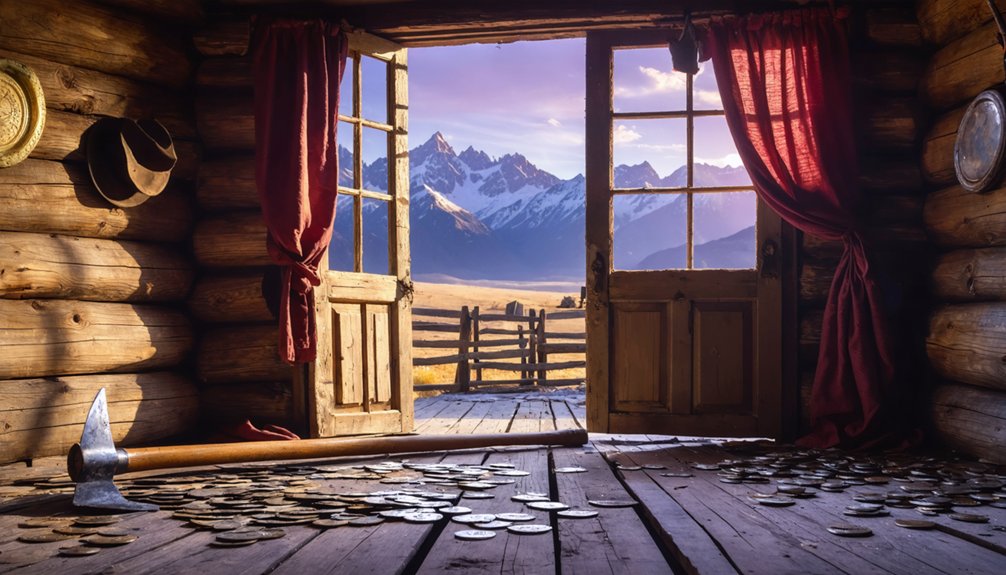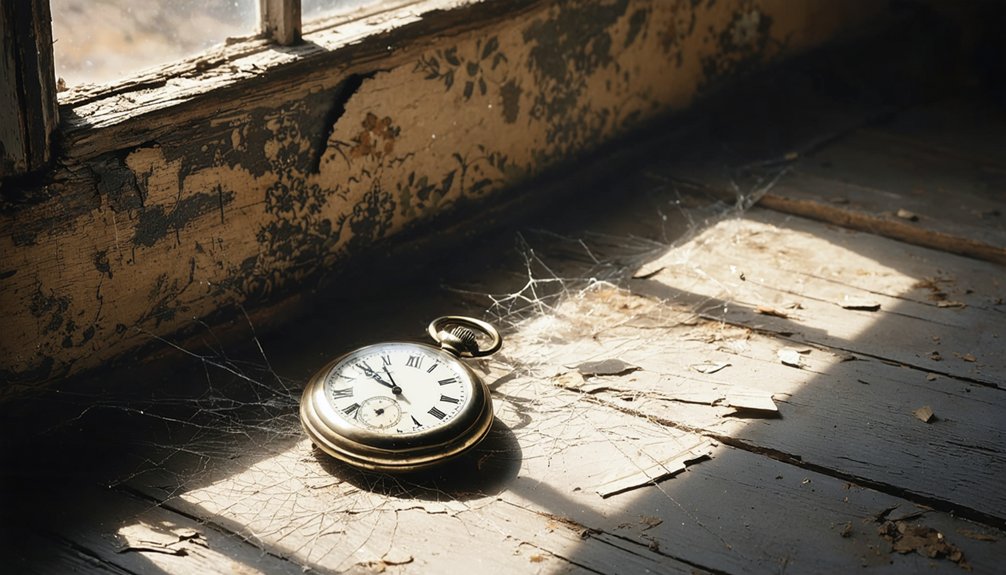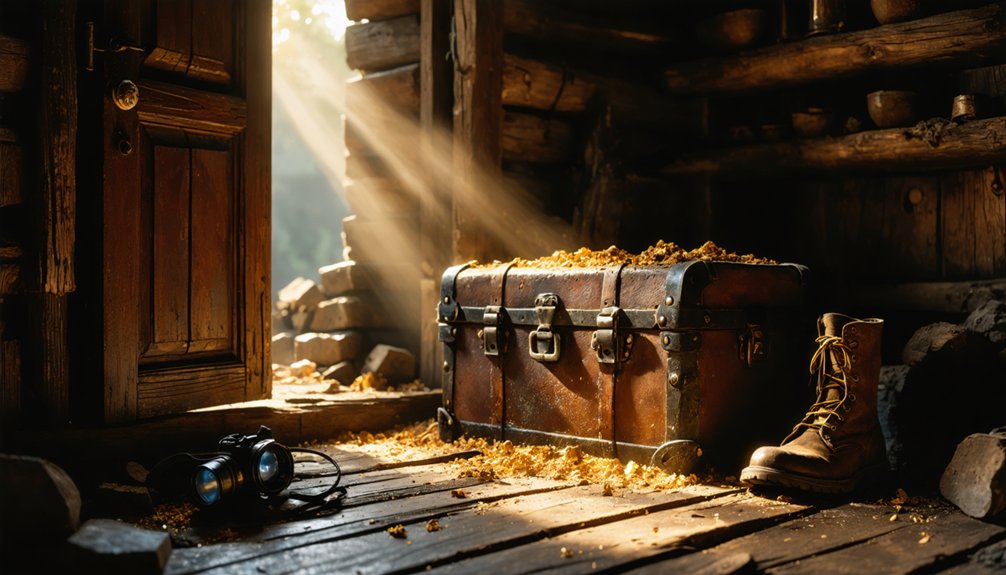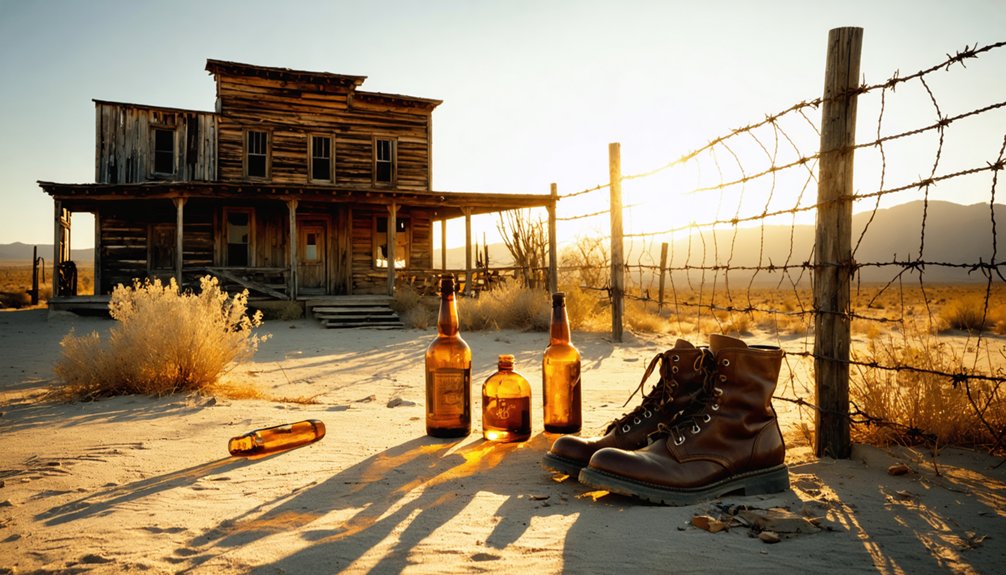Nevada’s ghost towns offer tangible connections to America’s mining past, with sites like Goldfield and Rhyolite showcasing remnants of boom-and-bust cycles. You’ll find architectural treasures, mining artifacts, and even paranormal experiences within these abandoned settlements. Pack all-terrain vehicles, navigation tools, and plenty of water when exploring these remote locations. Documented sites number over 800 across the state, each hiding unique stories beneath their weathered facades. The desert preserves more than just buildings.
Key Takeaways
- Artifacts like mining tools, antique bottles, and multicultural cemetery remnants tell stories of Nevada’s silver mining communities.
- Ghost towns such as Goldfield and Rhyolite feature preserved historical architecture including the Goldfield Hotel and 1908 Courthouse.
- Unique attractions include the Car Forest art installation, where abandoned vehicles serve as canvases for artistic expression.
- Nevada contains over 800 documented ghost town locations accessible through strategic routes like the Extraterrestrial Highway loop.
- Dawn and dusk photography at structures like the Bottle House creates opportunities to capture architectural features against desert landscapes.
The Rise and Fall of Silver State Boomtowns

As silver glittered beneath Nevada’s rugged terrain in the mid-19th century, the state witnessed an unprecedented transformation from barren desert to bustling economic centers.
You’ll find the story begins with the Comstock Lode‘s 1859 discovery, triggering a reverse migration from California as prospectors sought fortune in Virginia City.
The economic impact of silver mining can’t be overstated—towns like Belmont, Tonopah, and Goldfield exploded from nothing into thriving communities with grand architecture, lively saloons, and thousands of residents. The gold and silver strikes in Tonopah and Goldfield were particularly significant as they marked the last bonanzas in American mining history.
Silver transformed desert outposts into vibrant economic epicenters with ornate buildings and booming populations seemingly overnight.
Yet the pattern proved predictable: rapid growth followed by inevitable decline as ore deposits dwindled.
When mines failed, populations vanished, leaving behind the haunting shells that dot Nevada’s landscape today—silent reminders to boom-and-bust cycles that defined the Silver State. During this era, the Virginia and Truckee Railroad played a crucial role in connecting these isolated communities and facilitating the transport of valuable ore shipments to processing facilities.
Rhyolite: From Prosperity to Abandonment
When gold was discovered in the Bullfrog Mining District in 1904, Rhyolite emerged as one of Nevada’s most promising boomtowns, rapidly transforming from a primitive tent settlement into a substantial city with modern amenities.
By 1907, the population swelled to nearly 5,000 residents, with the town boasting electricity, railroads, and over 50 saloons.
Rhyolite’s architecture tells the story of its meteoric rise—the impressive three-story Cook Bank building, railroad depot, and unique Bottle House stand as evidence to the town’s former prosperity.
The town’s decline began when the San Francisco Earthquake disrupted investments in 1906, followed by the devastating financial Panic of 1907.
But by 1910, the ore deposits dwindled, banks closed, and residents fled.
The devastating fire of 1908 accelerated Rhyolite’s decline, destroying much of the business district and further discouraging investment in the struggling town.
Today, you’ll find these weathered structures among the most enchanting subjects for ghost town photography, with the Cook Bank ruins particularly popular among visitors seeking to capture Nevada’s boom-and-bust mining legacy.
Goldfield’s Glittering History and Haunted Present

When you visit Goldfield, you’ll experience the legacy of Nevada’s richest mining camp that produced over $90 million in ore and briefly became the state’s largest city with 30,000 residents by 1906.
You’ll find the imposing Goldfield Hotel, a $450,000 structure built during the boom that now ranks among Nevada’s most haunted buildings, with persistent stories about Elizabeth and other spectral residents.
Today, these historical remnants draw history enthusiasts and paranormal investigators alike who explore the town’s preserved structures while contemplating how quickly fortunes changed when fires, floods, and labor disputes hastened Goldfield’s decline. The catastrophic flood of 1913 washed away hundreds of buildings, with lost treasures including sacks of gold and safes full of coins never recovered. The town experienced a devastating fire in 1923 that destroyed 53 city blocks, further diminishing what remained of the once-thriving metropolis.
Gold Rush Glory Days
Beneath the dusty streets of present-day Goldfield lies a remarkable tale of meteoric rise and gradual decline that began in December 1902.
When prospectors Billy Marsh and Harry Stimler discovered gold on Columbia Mountain, they couldn’t have foreseen the explosion of prosperity their find would trigger.
Within three years, this barren landscape transformed into Nevada’s largest city, with over 20,000 fortune-seekers flooding the “Queen of the Mining Camps.”
Goldfield mining operations reached their zenith in 1908, producing $11 million in gold—equivalent to hundreds of millions today.
The economic impact was staggering; the Goldfield Consolidated Mining Company’s 100-stamp mill signaled industrial wealth on an unprecedented scale.
By 1905, the boomtown had evolved from a tent camp into an established city with substantial brick and stone buildings replacing the makeshift structures of its early days.
The town was officially established on October 20, 1903, after a meeting of 36 prospectors voted to change its name from Grandpa to Goldfield for promotional purposes.
You can still sense the echoes of labor struggles, flash floods, and fading dreams that ultimately returned Goldfield to the desert from which it spectacularly emerged.
Haunted Hotel Legends
The architectural crown jewel of Goldfield’s opulent past stands in stark contrast to its current reputation. The Goldfield Hotel, once symbolizing Nevada’s prosperity, now attracts visitors seeking ghostly encounters rather than luxury accommodations.
You’ll hear whispers of Elizabeth, allegedly chained in Room 109 during pregnancy, whose spectral presence manifests through apparitions and infant cries. George Wingfield’s cigar-smoking spirit reportedly lingers despite historical inconsistencies in this narrative.
The hotel’s spectral history extends to the third floor, where a hanged woman and a man who leapt from the roof supposedly wander. In the Gold Room, “The Stabber” threatens but never harms intrepid explorers.
While paranormal investigators—including TAPS from Ghost Hunters—have amplified these tales, remember that most legends lack historical verification, representing folklore rather than fact. Designed by architect George E. Holesworth, the hotel originally featured 154 luxurious rooms with telephones and electric lights when it opened in 1908. Despite its eerie reputation today, the building was once the most lavish hotel in Nevada during Goldfield’s prosperous boomtown era.
Modern Tourism Appeal
Today’s visitors to Goldfield experience an enchanting fusion of historical significance and supernatural intrigue, creating a tourism landscape unlike any other in Nevada. This former gold rush boomtown has transformed into a destination that’ll satisfy your yearning for freedom and exploration.
The town’s modern appeal stems from:
- Historical architecture – explore the 1908 Courthouse and infamous Goldfield Hotel, survivors of the devastating 1923 fire
- Paranormal adventures – join interactive ghost tours like Spirits of the Bordello featuring the town’s haunted past
- Artistic attractions – discover the Car Forest and Art Car Park Gallery, where vehicles become canvases
- Cultural experiences – wander streets where 20,000 residents once lived, now populated by artists and history enthusiasts
Photographing Nevada’s Ghost Town Architecture

Nevada’s ghost town architecture offers photographers rich opportunities to capture the artful decay of once-thriving communities through crumbling facades, weathered wood, and sun-bleached artifacts.
You’ll achieve the most compelling shots by mastering light techniques—photographing during golden hour for dramatic shadows or using HDR in harsh midday sun to balance exposure in deteriorating structures.
Documentation of forgotten buildings like Rhyolite’s Cook Bank and the Tom Kelly Bottle House preserves these vanishing historical treasures for future generations while creating striking visual compositions through wide-angle contextual shots and detailed close-ups of unique architectural elements.
Capturing Decay Artistically
Photographers seeking to capture the haunting beauty of Nevada’s ghost towns must approach these decaying structures with both technical skill and artistic vision.
The decay aesthetics of these abandoned settlements offer rich opportunities for storytelling through decay, revealing the passage of time and human absence.
To elevate your ghost town photography:
- Experiment with both black and white techniques to emphasize texture and contrast, and color to highlight vibrant decay tones like lime green or burnt orange.
- Vary your perspective with wide contextual shots and intimate close-ups of architectural details.
- Frame compositions through broken windows or gaps in walls to add narrative depth.
- Utilize reflections in weathered glass and metal surfaces to create layered compositions.
A tripod remains essential for capturing sharp images in these often dimly lit, historically rich environments.
Mastering Light Techniques
When traversing the spectral landscapes of abandoned settlements, mastering light techniques becomes essential for capturing the soul of ghost town architecture.
You’ll need to employ strategic light source strategies using flashlights with colored gels positioned at multiple angles to illuminate both interior and exterior surfaces thoroughly.
For ideal exposure techniques, lock your shutter open for 2-197 seconds while wearing dark clothing to move undetected through the scene.
Set your ISO between 200-3200 depending on ambient conditions, with apertures of f/5.6-f/8 balancing depth of field with light gathering capabilities.
Consider adjusting white balance to 4000K for preserving authentic night atmospheres.
Experiment with cool blue filters for spooky ambiance or warm lighting for authentic church interiors.
Position your tripod strategically, as stability becomes your greatest ally when painting these forgotten structures with light.
Documenting Forgotten Structures
Crumbling facades and weathered foundations tell silent stories across Nevada’s abandoned landscapes, waiting for your camera to resurrect their historical significance.
When documenting forgotten legacies in ghost towns like Rhyolite and Goldfield, you’ll encounter architectural treasures ranging from marble staircases to innovative bottle houses.
To capture decay documentation effectively:
- Focus on unique structures – Tom Kelly’s Bottle House and Cook Bank building offer compelling subjects with distinctive architectural elements.
- Consider seasonal lighting – Dawn illuminates stone walls while dusk accentuates structural silhouettes.
- Include scale references – Contextualizing the impressive three-story ruins against the desert backdrop.
- Document interiors when safe – Victorian details and mahogany finishings tell stories of past opulence.
These architectural remnants, though weathered by time, reveal Nevada’s remarkable mining era prosperity through thoughtful photography.
Essential Gear and Safety Tips for Ghost Town Explorers

Exploring Nevada’s ghost towns requires careful preparation and appropriate gear, as these remote historical sites often present unique challenges and potential dangers to the unprepared visitor.
Your vehicle selection is a critical gear essential—opt for reliable, all-terrain models equipped with recovery gear, spare tires, and necessary tools for self-rescue situations.
Safety protocols must include carrying ample water, non-perishable food, first-aid supplies, and navigation tools, as cell service is typically nonexistent.
When exploring, watch for open mine shafts, wildlife hazards, and deteriorating structures. Always adhere to the explorer’s code: leave artifacts undisturbed, respect private property, and avoid using historic structures for vehicle recovery.
Travel with companions when possible, and always inform someone of your itinerary before venturing into these fascinating but isolated historical treasures.
Belmont: Where History Stands Frozen in Time
Belmont stands as one of Nevada’s most compelling ghost towns, where time appears to have halted in the late 19th century. Founded in 1865 after a significant silver strike, this once-thriving mining center produced $15 million in ore before its inevitable decline in the 1890s.
The Belmont architecture tells a story of boom-and-bust prosperity, with remarkable preservation due to its remote location and arid climate. You’ll find the 1876 courthouse particularly impressive—a representation of the town’s former status as Nye County seat.
When exploring Belmont mining history, note these key features:
- The Monitor-Belmont Mill chimney, once used for target practice by WWII pilots
- Original buildings allowing self-guided walking tours
- Visible tramline remains that showcase mining operations
- Brick structures stripped of timber after abandonment
Paranormal Experiences in Nevada’s Abandoned Mining Camps

Beyond the architectural relics and mining artifacts, Nevada’s abandoned camps harbor a darker allure that draws countless visitors each year—their reputation for paranormal activity.
You’ll find the most intense haunted encounters at notorious locations like the Goldfield Hotel and Techatticup Mine, where miners who died violently are said to remain restless.
As you explore these desolate sites, be alert for common phenomena: apparitions moving through crumbling buildings, unexplained footsteps echoing in empty corridors, and sudden cold spots in the desert heat.
The spectral sightings at Rhyolite, Pioche, and Nelson aren’t merely campfire tales—they’re documented experiences shared by skeptics and believers alike.
These paranormal elements stem from the brutal realities of frontier life: lawlessness, treachery, and the harsh conditions that claimed countless lives in Nevada’s mining heyday.
Preservation Efforts Saving Nevada’s Forgotten Past
While the eerie allure of haunted mines and spectral encounters draws many visitors to Nevada’s ghost towns, a robust network of preservation initiatives works tirelessly behind the scenes to protect these fragile historical treasures.
You’ll find Nevada’s cultural heritage safeguarded through extensive efforts guided by the NSHPO’s statewide plan, which prioritizes protecting diverse sites from rock art to mining camps.
Community involvement stands at the heart of these initiatives, with local volunteers and organizations actively participating in:
- Restoration projects using original materials and techniques
- Regular monitoring of sites to prevent vandalism and theft
- Educational programs through interpretive signs and visitor centers
- Adaptive reuse of historic structures like the Goldfield Hotel
Beyond Buildings: Finding Artifacts and Untold Stories
Venturing past the weathered façades and crumbling foundations, you’ll discover that Nevada’s ghost towns harbor treasures far beyond their architectural remains.
Mining tools, antique bottles, and personal effects dating from the late 1800s emerge near abandoned saloons and mine shafts, each telling its own story of boom-and-bust cycles.
Artifact preservation efforts protect these historical items—remember that removing them is illegal under state and federal laws. Instead, document your discoveries through photographs and contribute to oral histories that record diverse narratives of immigrants, veterans, and outlaws.
Preserve history by leaving artifacts where they lie; their stories belong to us all.
You can explore cemetery sites like Goldfield’s, where the infamous “Paste Eater’s Grave” and Serbian plots reveal multicultural influences.
For a contemporary twist, visit the Goldwell Open Air Museum near Rhyolite, where modern art installations create striking contrasts against historical ruins.
Planning Your Ghost Town Road Trip Through Nevada
The lure of Nevada’s ghost towns becomes irresistible once you’ve learned about their hidden treasures, but traversing this desert landscape requires thoughtful preparation.
With over 800 documented locations across Nevada, a well-planned route maximizes ghost town photography opportunities while respecting their historical significance.
Consider these essential planning elements:
- Choose a strategic route – the Extraterrestrial Highway loop from Las Vegas or Highway 95 connecting Rhyolite to Reno offers efficient exploration.
- Pack survival essentials – extra water, car repair kit, and reliable communication device for areas without cell reception.
- Share your itinerary with trusted contacts before venturing into remote areas.
- Contact BLM offices for current road conditions, especially for routes requiring four-wheel drive access.
Frequently Asked Questions
What Permits Are Required to Legally Collect Artifacts From Ghost Towns?
You can’t legally collect artifacts from ghost towns. Artifact laws prohibit removal from public lands, and collection guidelines stipulate that historic sites aren’t open for collecting without proper federal and state permits.
How Did Transportation Networks Influence Ghost Town Locations and Longevity?
You’ll discover ghost towns strategically positioned along transportation routes. Their economic viability depended on rail connectivity—multiple lines meant longer survival, while isolated locations quickly vanished when transportation networks shifted elsewhere.
Which Ghost Towns Have Active Mining Claims Visitors Should Avoid?
When exploring Midas, Rio Tinto remnants, or areas near Nye County’s Amargosa Valley, you’ll need safety precautions as active claims exist. Check local BLM records before venturing into these historical sites.
Are There Documented Cases of Missing Persons in Nevada Ghost Towns?
Like swiping through a digital yearbook of the missing, you’ll find documented cases including William James and Aidan Clune—both vanished from Nevada’s remote ghost towns, adding to their haunting legends and mysteries.
What Seasonal Timing Offers the Best Weather for Ghost Town Exploration?
Fall offers the ideal conditions for ghost town exploration, with comfortable temperatures and excellent visibility. You’ll avoid summer’s dangerous heat while enjoying fewer tourists during your fall adventures across Nevada’s historical landscapes.
References
- https://en.wikipedia.org/wiki/List_of_ghost_towns_in_Nevada
- https://nvtami.com/top-10-ghost-towns-nevada-northwest/
- https://www.visittheusa.com/experience/6-nevada-ghost-towns-explore-if-you-dare
- https://www.smithsonianmag.com/sponsored/nevadas-living-and-abandoned-ghost-towns-180983342/
- https://www.nevadaghosttownsandmininghistory.com
- https://www.youtube.com/watch?v=lXyHDThvoLU
- https://nvtami.com
- https://travelnevada.com/ghost-town/
- https://forgottennevada.org/sites/newlist.html
- https://wheninyourstate.com/nevada/14-nevada-boomtowns-where-silver-strikes-made-gamblers-into-millionaires/



